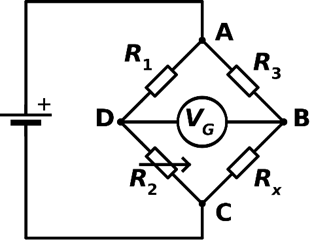The measurement of an unknown resistance R is to be carried out using Wheat stones bridge (see Fig. 3.25 of NCERT Book). Two students perform an experiment in two ways. The first students take R2 = 10Ω and R1 = 5 Ω. The other student takes R2 = 1000 Ω and R1 = 500 Ω. In the standard arm, both take R3 = 5 Ω. Both find ![]() within errors.
within errors.
A Wheatstone bridge is an arrangement of four resistances, which under a balanced condition can help us find out a resistance, if the other three are given.
For a balanced Wheatstone bridge,
![]()
![]()
Substituting the values of R2, R1 and R3 for student 1 we get RX as 10Ω.
Doing the same for student 2 we again get RX=10Ω.
The errors in the calculation depends on the sensitivity of the bridge which depends on the resistances involved. If R2 and R3 are very large, the current from these arms would be proportionately small and thus will make it difficult to locate a null point.
As different setups of Wheatstone bridge are used (with different resistances) errors in both cases will differ.

Hence, option (b) and (c) are correct.